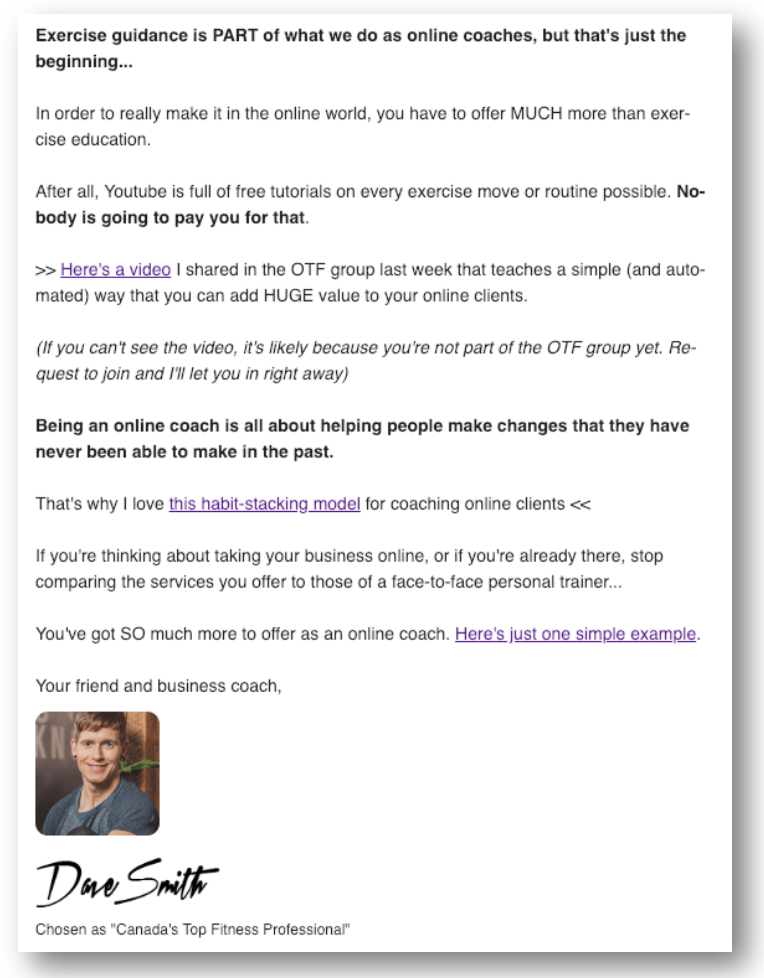 By Dave Smith, Special AFS Contributor
By Dave Smith, Special AFS Contributor
Email marketing isn’t something many fitness studio owners want to tackle. It sounds like a lot of work to write emails monthly, weekly, or even daily, and perhaps any efforts you’ve tried in the past turned up empty.
That’s why so many fitness studios let their email list collect dust. There are more important things to focus on, right?
Wrong.
Email marketing for personal trainers and fitness studio owners doesn’t have to be a lot of work, and it can drive huge incremental revenue… when done properly.
That’s why you need to learn and implement these 3 low-effort ways you can use your email list to build your business:
1. The “Welcome” Email
What happens when a new member joins your studio? At best, she likely gets added to your monthly newsletter list and that’s about it.
If that’s the case, there’s a huge opportunity for you to improve your new-client experience with one simple welcome email.
The goal of the welcome email is to eliminate any buyer’s remorse (i.e. you want your new clients to feel confident that they made the right choice by joining your studio). You can accomplish this in two ways:
First, offer a checklist of items that a new client needs to know or ones that he might forget about. For example, include your studio hours, your class schedule, what he should bring when he comes to the studio, as well as tips that will help him get the best results possible. In other words, show him that you care about his success, not just the sale you made when he joined your studio.
Second, integrate him into your community immediately.
In today’s fitness-focused world, it seems as though there are fitness studios on every corner of every city. Competition is fierce, so you need to consider your “stickiness.”
A business is “sticky” when it would be hard for a customer to pull away and go elsewhere. For example, if a gym member goes to that gym simply to use a treadmill, there isn’t much stickiness. She can go to any other gym to the exact same experience, so her loyalty to her gym will be low.
In contrast, the ultimate stickiness is formed through community. A member of your studio won’t want to leave if doing so would remove her from a community that she loves.
Next question: How do you create that sticky community?
Some of it will happen in your studio. Your classes bring people together. Your instructors engage their audience. But, you can also form a very sticky community online by creating a Facebook group for all of your studio members.
I know what you might be thinking: “Dave, I don’t have time to manage a Facebook group!”
That’s true IF you operate your group the way most people do. Most Facebook groups consist of the owner posting content, asking questions, and working their butt off to keep members engaged.
You’re NOT going to do that.
Instead, your Facebook group becomes the hub for everything you do outside of the studio.
- If someone emails you a workout question, you direct her to the group to copy and paste her question there instead.
- When a client sends you an excited message after he dropped 5 pounds, you remind him that everyone in the group will want to hear too.
- When someone needs motivation, you ask her to reach out in the group, and then you can tag other members who have faced similar struggles.
You set the tone for this group. You create a culture of sharing and supporting.
Soon you’ll realize that the group needs you less and less and that it has become a sticky community that your clients will never want to leave, which means greater client retention and more future sales for your business.
2. The “Reminder” Email
As I mentioned earlier, many business owners shy away from email marketing because they think it entails a lot of content creation. They think it will be another to-do item added to their already long list.
That’s doesn’t have to be the case.
If you are active on any social media platform, whether it is Facebook, Instagram, Youtube, or any other, you’re already creating lots of content. You don’t need to create more. Instead, you just need to improve your reach.
You’ve likely heard that social media sites are continually reducing the “organic” reach of your posts. In other words, fewer and fewer people are seeing your content unless you run paid ads.
This is where a “reminder” email comes into play.
Imagine you post a Facebook live video on your personal profile where you talk about counting macronutrients. Even if you share this video on your business page and in your Facebook group, there will still only be a small percentage of your followers who ever see it. There is just too much content being produced these days for Facebook to show everything to everyone.
To combat this, you can send an email to your email list that directs them to your original video. This email acts as an announcement to those who missed seeing your post and it acts as a reminder to those who saw it but didn’t consume it entirely.
Here’s part of one such reminder email that I sent to my Online Trainers Federation email list:

This took about 5 minutes to write and it will lead hundreds of viewers to a piece of content that I’ve already created.
PRO TIP: If your reminder email directs people to a piece of content that’s posted within your closed Facebook group (like I did here), it gives them incentive to join because they can’t access the content without being part of the group.
If you’re not sending out reminder emails, every piece of content you publish online is missing the mark. In order to drive future sales, you must nurture your existing audience. Sending reminder emails is a great way to get more eyeballs on your content so that those followers turn into paying customers down the road.
3. The “Holiday” Message
A mistake many rookie marketers make is “burning out” their email list. This happens when a business owner sends one promotional email after another. Each message is a “Buy This!” message, and pretty soon the recipients stop opening.
Here’s the rule of thumb I follow: About 75% of the emails I send are non-promotional (e.g. like the welcome and reminder messages we just covered), and the remaining 25% are sales emails.
Imagine you send one email to your list each week, a practice I follow and recommend, that means that 3 weeks per month are dedicated to providing valuable content and one week is all about selling. Follow this pattern and you’ll never burn out your list.
Now that you know how often to make an offer via email, it’s time to craft engaging messages that actually sell. One of my favorite ways of doing this is through a “holiday” message. A holiday is a message is just like it sounds: It’s a reason to offer your list something special.
Obvious holiday messages could be a discount at Christmas or a special offer in time for New Year's resolutions, but you can be much more creative than that. For example, every year I send my email list a “birthday gift” on my birthday. This gift might be a discount code, early access to a new fitness program, or entry into a contest of some sort. You get the idea.
The goal of holiday messages is to pair your email offers with something seasonal, exciting, or fun that gives members on your list a reason to open your sales emails. I recommend that you plan these out at least three months in advance.
- What holidays or special occasions are coming up?
- How can you tie those events into a promotion for your products and services?
Eventually, your list will be trained to expect, and look forward to, your promotional emails. I have proof – After running my birthday promotion for several consecutive years, I missed one, and my email list let me know. “Dave, where’s the birthday gift this year?” they asked me.
Conclusions
Successful email marketing does take a bit of work to implement, but once you have a system in place, it’s a low-effort way to stay top-of-mind with your current and former clients.
Implementing the three simple email strategies I shared here is a low-effort way to nurture your email list. This costs you nothing and can result in huge short-term and long-term sales for your studio.
Dave Smith is an online health coach who was chosen as “Canada’s Top Fitness Professional” in 2013. He is the founder of the Online Trainers Federation, where he focuses on helping fitness professionals grow their brands and online businesses. Check out his business-building resources and podcast at onlinetrainersfederation.com.


Join the Conversation!